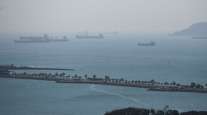Road Woes Could Impede New Freight From Panama Canal, Byrd Warns Senate
This story appears in the April 15 print edition of Transport Topics.
Substandard highway infrastructure in the United States will make it difficult for trucking to handle the additional freight demand at East and Gulf Coast ports once expansion of the Panama Canal is completed, a leader of American Trucking Associations told a Senate panel.
“The biggest challenge to accommodating increased freight volumes lies outside the port gates — specifically, the ability of our congested highways to handle the increased freight,” Phil Byrd, president of Bulldog Hiway Express, said at the April 10 hearing of the Senate Commerce, Science and Transportation Committee.
Byrd is also first vice chairman of ATA.
Panama is wrapping up a nine-year, more than $5 billion project to add a third lane to the canal, the first major expansion since it opened in 1917. The new lane will be able to handle ships about 2.5 times the maximum size of the existing lanes.
Current maximum ship size allows for about 5,000 20-foot-equivalent unit containers. New maximum ship size will be about 12,000 TEUs, according to the Panama Canal Authority.
Panama expects to open the new lane by the middle of 2015.
Bulldog Hiway Express is the largest carrier serving the Port of Charleston, S.C., Byrd told the panel. He said that port, like others nearby, is preparing for larger ships and increased traffic through projects such as dredging the harbor to 50 feet.
“Clearly, while port infrastructure may potentially be ready to handle increased container volumes, outside the port gates, our intermodal connectors and highway system are not,” Byrd said.
Byrd cited a recent report from the American Society of Civil Engineers that gave the country’s road infrastructure a D+. The same report said urban highway congestion costs the country $101 billion annually in wasted time and fuel.
The hearing convened the same day President Obama proposed immediately spending $50 billion to upgrade the country’s infrastructure and a 5.5% increase in the Transportation Department’s budget for 2014.
ATA criticized that proposal for not being specific enough.
Byrd said upcoming changes to hours-of-service rules for truck drivers, set to take effect July 1, will also hamper truckers at ports.
“The rule will likely decrease trucking productivity by 2% to 3%,” he said. “But in port operations like mine, the impact will be much greater. And there’s no scientific basis for the new rule change.”
Even with the poor infrastructure and regulatory problems, Byrd sought to assure the committee that the trucking industry would handle the additional freight that will likely come to the Eastern Seaboard. “Our industry is incredibly adaptable, and prepared to handle the increased need and demand,” he said.
Lawmakers and witnesses at the hearing agreed that it is difficult to predict exactly how the canal’s expansion will change traffic patterns and needs.
“The Panama Canal is poised to once again dramatically affect the movement of goods in and throughout the Western Hemisphere,” Sen. Jay Rockefeller (D-W.Va.), the Commerce Committee’s chairman, said in opening the hearing. “However, it’s unclear how the expanded canal will affect trade patterns.”
John Vickerman, president of Vickerman & Associates, predicted that East Coast ports will see increased traffic from Asia using the Panama Canal to reach U.S. population centers but that volumes on West Coast ports aren’t likely to lose much traffic.
Rockefeller agreed with Byrd that while the focus in recent years has been on port infrastructure, “there is a world beyond the ports, and businesses need to move their goods throughout the country.” He called for “a strategic, long-term vision for rebuilding our transportation system” in light of the canal’s expansion and its effect on global commerce.
Ed Hamberger, president of the Association of American Railroads, said his industry has spent $500 billion in the past three decades on infrastructure and equipment and will be prepared for whatever changes the Panama Canal could bring.
“All this investment is aimed at keeping the U.S. freight rail industry second to none in the world,” he said.



